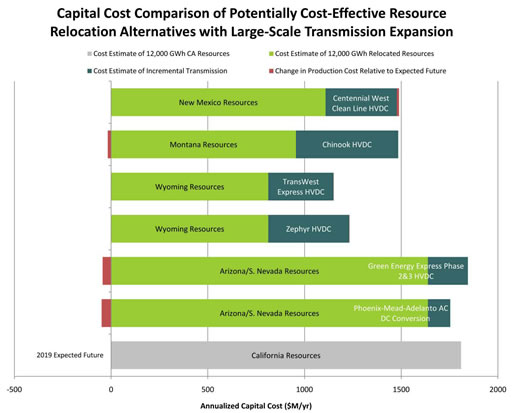Sept. 29, 2011 – Echoing the findings of previous electric industry analyses, a new study by the Western Electricity Coordinating Council shows that Wyoming is the best source of cost-effective, high-capacity renewable energy to help meet the demands of California’s future energy market.
Approved by the WECC board on Sept. 22, the U.S. Department of Energy-funded “10-Year Regional Transmission Plan” study provides WECC’s first interconnection-wide transmission plan and an interconnection-wide perspective on future energy transmission and generation. WECC coordinates the bulk electric system across the Western U.S. and Canada.
In the year 2020, the demand for additional renewable energy to meet Renewable Portfolio Standards is greater in California than in any other Western state – representing 66% of all of the renewable energy demand in the WECC region, the 10-Year Plan notes.
As stated in a news release by the Wyoming Infrastructure Authority, California currently intends to meet its demand using renewable energy projects developed in California and has policies that generally favor in-state renewable development. However, WECC’s analysis indicates that if California would choose to meet just 20% of its demand with deliveries of high-capacity wind energy from Wyoming as delivered over the TWE Project, California ratepayers could save on the order of $600 million every year, translating to billions of dollars in savings for those customers over time.
“Results presented in the Plan suggest there are opportunities for regional transmission and renewable resource development that should not be overlooked as states implement their own energy policies... so as not to forego potential economic and environmental benefits that may accrue to their ratepayers,” the Plan Summary says.
Economic analysis conducted as part of WECC’s 10-Year Plan indicates the TWE Project can provide the most cost-effective remote renewable energy resource alternative to satisfy a portion of California’s needs (see chart below).
The full WECC 10-Year Regional Transmission Plan can be found at www.wecc.biz. The Plan was produced using a broad stakeholder process including regulators from states such as California, sub-regional transmission planning groups, utilities, environmental groups and federal agencies such as the Department of Energy.
The Plan’s economic results are consistent with previous studies by Western Electric Industry Leaders and National Grid that underscored the economic benefits of tapping Wyoming’s high-capacity wind energy to meet a portion of California’s massive renewable energy demand. According to National Grid, for example, the Desert Southwest region (Southern California, Arizona and Nevada) will require nearly 55,000 GWh of incremental renewable energy production by 2020. The TWE Project could meet nearly one-third of that demand with the efficient, cost-effective and economically feasible transmission of approximately 20,000 GWh/year of clean and sustainable electric energy from Wyoming.
Based on the strength of these previous analyses, development of the TWE Project has been pursued aggressively since 2008. It is on pace or ahead of other planned transmission projects in the western United States. Western Area Power Administration and the U.S. Bureau of Land Management are joint lead agencies for the ongoing preparation of an Environmental Impact Statement for the TWE Project. The Draft Environmental Impact Statement is planned to be available for public comment in mid-2012, with a Final Environmental Impact Statement planned by 2013 and an in-service date of 2016 – aligned with WECC’s 10-year planning horizon.
For more information about the TWE Project, visit www.transwestexpress.net.

Source: WECC 10-Year Regional Transmission Plan Summary, Page 30
- XXX -

